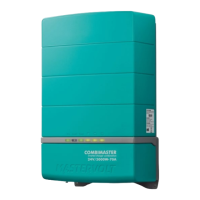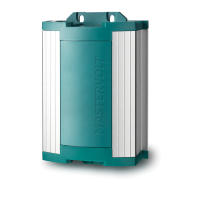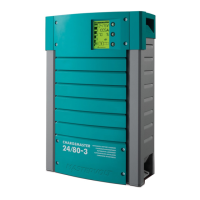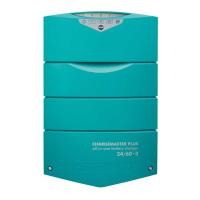– User and Installation Manual
1.2 Warnings regarding the use of batteries
1. WARNING – RISK OF EXPLOSIVE GASES
i. WORKING IN VICINITY OF A LEAD-ACID BATTERY IS DANGEROUS. BATTERIES
GENERATE EXPLOSIVE GASES DURING NORMAL BATTERY OPERATION. FOR
THIS REASON, IT IS OF UTMOST IMPORTANCE THAT EACH TIME BEFORE
SERVICING THE COMBIMASTER INVERTER/CHARGER IN THE VICINITY OF THE
BATTERY, YOU READ THIS MANUAL AND FOLLOW THE INSTRUCTIONS
EXACTLY.
ii. To reduce risk of battery explosion, follow these instructions and those published by battery
manufacturer and manufacturer of any unit you intend to use in vicinity of battery. Review
cautionary marking on these products and on engine.
2. PERSONAL PRECAUTIONS
i. Someone should be within range of your voice or close enough to come to your aid when you
work near a lead-acid battery.
ii. Have plenty of fresh water and soap nearby in case battery acid contacts skin, clothing, or eyes.
iii. Wear complete eye protection and clothing protection. Avoid touching eyes while working near
battery.
iv. If battery acid contacts skin or clothing, wash immediately with soap and water. If acid enters
eye, immediately flood eye with running cold water for at least 10 min and get medical attention
immediately.
v. NEVER smoke or allow a spark or flame in vicinity of battery or engine.
vi. Do not short circuit battery! Be extra cautious to reduce risk of dropping a metal tool onto
battery. It might spark or short-circuit battery or other electrical part that may cause explosion.
vii. Remove personal metal items such as rings, bracelets, necklaces, and watches when working
with batteries. A battery can produce a short-circuit current high enough to weld a ring or the like
to metal, causing a severe burn.
viii. NEVER charge a frozen battery.
ix. If necessary, to remove battery from a vessel or vehicle, always remove grounded terminal from
battery first. Make sure all accessories in the vessels or vehicle are off, so as not to cause an
arc.
x. Be sure that the area around battery is well ventilated.
xi. Clean battery terminals. Be careful to keep corrosion from coming in contact with eyes.
xii. Study all battery manufacturer’s specific precautions such as removing or not removing cell caps
while charging and recommended rates of charge.
xiii. Add distilled water in each cell until battery acid reaches level specified by battery manufacturer.
This helps purge excessive gas from cells. Do not overfill. For a battery without cell caps (e.g.
AGM, Gel or Li-ion batteries), carefully follow manufacturer’s recharging instructions.
xiv. A battery is heavy! It may become a projectile if it is involved in an accident! Ensure adequate
and secure mounting and always use suitable handling equipment for transportation.

